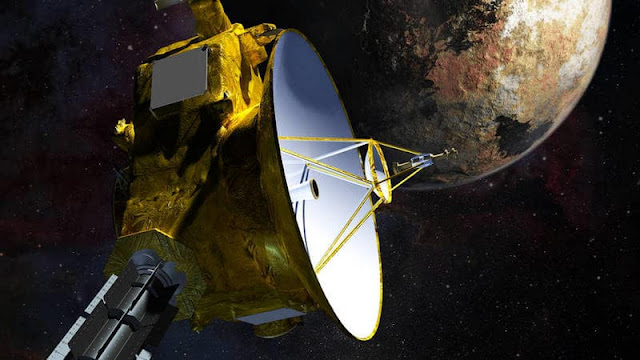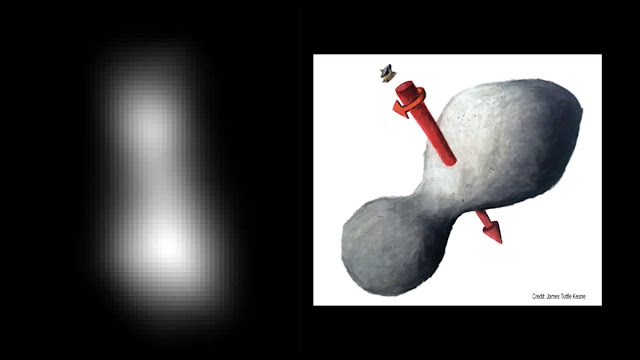The new year on Earth began with a record-setting space mission 4 billion miles away a first look at an entity on the edge of our solar system.
Mission scientists from NASA and the Johns Hopkins University
Applied Physics Laboratory have established that the New Horizons spacecraft
conducted a flyby of Ultima Thule, a Kuiper Belt object that’s a billion miles
beyond Pluto.
Although the flyby happened at 12:33 a.m. ET on Tuesday, the
spacecraft is so far away from Earth that the “phone-home” signal didn’t range
us till about 10:30 a.m. ET.
Mission scientists were pleased about the success because there
was only one coincidental to get it right as New Horizons screamed past Ultima
at 31,500 miles per hour. This unbelievable feat was conceivable because
thousands of processes on the spacecraft worked in sync.
“We’ve just accomplished the most distant flyby,” mission
operations manager Alice Bowman alleged. “This science will help us understand
the origins of our solar system.”
New Horizons has also directed back a first look at Ultima Thule
— taken from half a million miles out, so pardon the pixels.
This is the best look scientists have ever had at Ultima. Before, they saw it as only a single pixel.
“It’s a better pixelated blob,” alleged Principal Investigator Alan Stern of the Southwest Research Institute in Boulder, Colorado.
This is the best look scientists have ever had at Ultima. Before, they saw it as only a single pixel.
“It’s a better pixelated blob,” alleged Principal Investigator Alan Stern of the Southwest Research Institute in Boulder, Colorado.
The image exposed that the entity appears to have a bowling
pin-like shape, elongated and spinning like a propeller. It’s also could be two
objects closely orbiting each other, but only more data will show for sure. The
object is 20 miles long by 10 miles wide.
Expect never-before-seen high-resolution pictures and new
science to come flooding in Wednesday and over the next few days.
“The data we have look fantastic, and we’re already learning
about Ultima from up close,” Stern alleged. “From here out, the data will just
get better and better.”
Brian May, the guitarist for the legendary rock band Queen and
an astrophysicist, is also a participating scientist in the New Horizons
mission. He’s particularly involved in stereo imaging for this leg of the
mission. He was also stimulated to announcement a new song celebrating New
Horizons on New Year’s Day.
“This mission represents to me the spirit of adventure,
discovery and inquiry which is inherent in the human spirit,” May alleged
during the countdown to the flyby. He wrote a track to uprightness the mission
called “New Horizons
(Ultima Thule Mix).”
And even the US government closure couldn’t stop NASA from
celebrating such an extraordinary feat.
“Congratulations to NASA’s New Horizons team, Johns Hopkins
Applied Physics Laboratory and the Southwest Research Institute for making
history yet again. In addition to being the first to discover Pluto, today New
Horizons flew by the most distant object ever visited by a spacecraft and
became the first to directly explore an object that holds remnants from the
birth of our solar system,” NASA Administrator Jim Bridenstine alleged. “This
is what leadership in space exploration is all about.”
What is Ultima Thule?
The object is so ancient and pristine that it’s basically like
going back in time to the foundation of our solar system.
This flyby is the first survey of a small Kuiper Belt object up
close — and the most primitive world ever experiential by a spacecraft.
The Kuiper Belt is the edge of our solar system, part of the
original disk from which the sun and planets shaped. The craft is now so far
from Earth that it takes six hours and eight minutes to obtain a command from
Earth.
If New Horizons sounds familiar, it’s because this is the
spacecraft that conducted a historic flyby of Pluto in 2015, sending back unprecedented pictures
of the dwarf planet and revealing new details about Pluto and its moons.
The New Horizons mission was extended in 2016 to visit this Kuiper Belt object. The
mission was launched in 2006 and took a 9½-year journey through space before
reaching Pluto.
New Horizons flew three times closer to Ultima than it did by
Pluto, coming within 2,200 miles of it and provided that a better look at the
surface. After the quick flyby, New Horizons will continue on through the
Kuiper Belt with other planned observations of more objects, but the mission
scientists said this is the highlight.
The object was previously known as 2014 MU69. The name Ultima
Thule was chosen through a nickname campaign hosted by the New Horizons team.
Thule was a mythical island on medieval charts, thought to be
the northernmost point on Earth. Ultima Thule essentially means “beyond Thule,”
which suggests something that lies beyond what is known. It’s fitting,
considering New Horizons’ pioneering journey.


Comments
Post a Comment